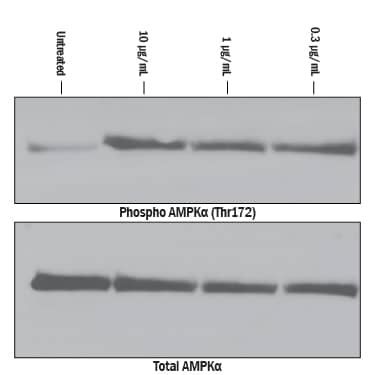Recombinant Human CTRP5/C1qTNF5 Protein, CF
R&D Systems, part of Bio-Techne | Catalog # 9510-TN

Key Product Details
Product Specifications
Source
Mouse myeloma cell line, NS0-derived human CTRP5/C1qTNF5 protein
Ser16-Ala243, with Gln44Arg substitution and a C-terminal 6-His tag
Ser16-Ala243, with Gln44Arg substitution and a C-terminal 6-His tag
Purity
>85%, by SDS-PAGE visualized with Silver Staining and quantitative densitometry by Coomassie® Blue Staining.
Endotoxin Level
<0.10 EU per 1 μg of the protein by the LAL method.
N-terminal Sequence Analysis
Ser16
Predicted Molecular Mass
25 kDa
SDS-PAGE
26-32 kDa, reducing conditions
Activity
Measured by its ability to induce phospho AMPK activation in C2C12 mouse differentiated myocytes.
300 ng/mL of Recombinant Human CTRP5/C1qTNF5 induces phosphorylation of AMPK.
Measured by its binding ability in a functional ELISA.
When Recombinant Human MFRP (Catalog # 1915-MF) is immobilized at 2 μg/mL, 100 μL/well, the concentration of Recombinant Human CTRP5/C1qTNF5 that produces 50% of the optimal binding response is 0.3-1.8 μg/mL.
300 ng/mL of Recombinant Human CTRP5/C1qTNF5 induces phosphorylation of AMPK.
Measured by its binding ability in a functional ELISA.
When Recombinant Human MFRP (Catalog # 1915-MF) is immobilized at 2 μg/mL, 100 μL/well, the concentration of Recombinant Human CTRP5/C1qTNF5 that produces 50% of the optimal binding response is 0.3-1.8 μg/mL.
Scientific Data Images for Recombinant Human CTRP5/C1qTNF5 Protein, CF
Recombinant Human CTRP5/C1qTNF5 Protein Bioactivity
Recombinant Human CTRP5/C1qTNF5 Induces Phosphorylation of AMPK in C2C12 Differentiated Myocytes. C2C12 differentiated myocytes were treated with Recombinant Human CTRP5/C1qTNF5 (Catalog # 9510-TN) for 1 hour prior to Western blot analysisFormulation, Preparation and Storage
9510-TN
| Formulation | Lyophilized from a 0.2 μm filtered solution in HEPES and NaCl. |
| Reconstitution |
Reconstitute at 200 μg/mL in PBS.
|
| Shipping | The product is shipped at ambient temperature. Upon receipt, store it immediately at the temperature recommended below. |
| Stability & Storage | Use a manual defrost freezer and avoid repeated freeze-thaw cycles.
|
Background: CTRP5/C1qTNF5
References
- Wong, G.W. et al. (2004) Proc. Natl. Acad. Sci. U. S. A. 101:10302.
- Thanasupawat, T. et al. (2015) Front. Endocrinol. (Lausanne) 6:127.
- Park, S.Y. et al. (2009) J. Biol. Chem. 284:27780.
- Schäffler A. and Buechler C. (2012) Trends Endocrinol. Metab. 23:194.
- Tu X. and Palczewski K. (2014) J. Struct. Biol. 186:86.
- Mandal M.N. et al. (2006) Invest. Ophthalmol. Vis. Sci. 47:5505.
- Lei X. et al. (2016) Am. J. Physiol. Endocrinol. Metab. 310:E1036.
Long Name
C1q And Tumor Necrosis Factor Related Protein 5
Alternate Names
C1qTNF5
Gene Symbol
C1QTNF5
UniProt
Additional CTRP5/C1qTNF5 Products
Product Documents for Recombinant Human CTRP5/C1qTNF5 Protein, CF
Product Specific Notices for Recombinant Human CTRP5/C1qTNF5 Protein, CF
For research use only
